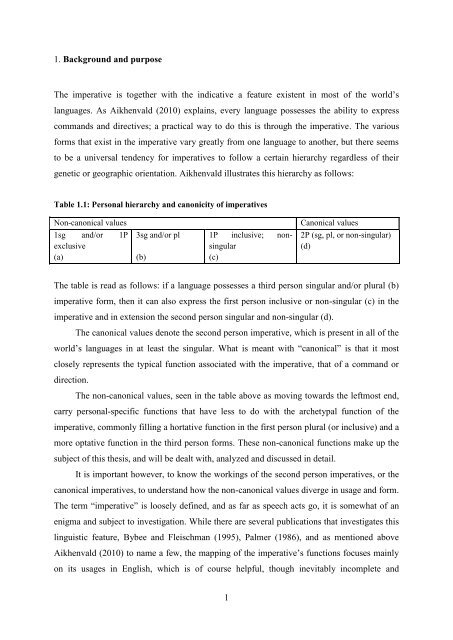The function of non-canonical imperatives in the languages of Europe
The function of non-canonical imperatives in the languages of Europe
The function of non-canonical imperatives in the languages of Europe
You also want an ePaper? Increase the reach of your titles
YUMPU automatically turns print PDFs into web optimized ePapers that Google loves.
1. Background and purpose<br />
<strong>The</strong> imperative is toge<strong>the</strong>r with <strong>the</strong> <strong>in</strong>dicative a feature existent <strong>in</strong> most <strong>of</strong> <strong>the</strong> world’s<br />
<strong>languages</strong>. As Aikhenvald (2010) expla<strong>in</strong>s, every language possesses <strong>the</strong> ability to express<br />
commands and directives; a practical way to do this is through <strong>the</strong> imperative. <strong>The</strong> various<br />
forms that exist <strong>in</strong> <strong>the</strong> imperative vary greatly from one language to ano<strong>the</strong>r, but <strong>the</strong>re seems<br />
to be a universal tendency for <strong>imperatives</strong> to follow a certa<strong>in</strong> hierarchy regardless <strong>of</strong> <strong>the</strong>ir<br />
genetic or geographic orientation. Aikhenvald illustrates this hierarchy as follows:<br />
Table 1.1: Personal hierarchy and ca<strong>non</strong>icity <strong>of</strong> <strong>imperatives</strong><br />
Non-ca<strong>non</strong>ical values<br />
Ca<strong>non</strong>ical values<br />
1sg and/or 1P<br />
exclusive<br />
(a)<br />
3sg and/or pl<br />
(b)<br />
1P <strong>in</strong>clusive; <strong>non</strong>s<strong>in</strong>gular<br />
(c)<br />
2P (sg, pl, or <strong>non</strong>-s<strong>in</strong>gular)<br />
(d)<br />
<strong>The</strong> table is read as follows: if a language possesses a third person s<strong>in</strong>gular and/or plural (b)<br />
imperative form, <strong>the</strong>n it can also express <strong>the</strong> first person <strong>in</strong>clusive or <strong>non</strong>-s<strong>in</strong>gular (c) <strong>in</strong> <strong>the</strong><br />
imperative and <strong>in</strong> extension <strong>the</strong> second person s<strong>in</strong>gular and <strong>non</strong>-s<strong>in</strong>gular (d).<br />
<strong>The</strong> ca<strong>non</strong>ical values denote <strong>the</strong> second person imperative, which is present <strong>in</strong> all <strong>of</strong> <strong>the</strong><br />
world’s <strong>languages</strong> <strong>in</strong> at least <strong>the</strong> s<strong>in</strong>gular. What is meant with “ca<strong>non</strong>ical” is that it most<br />
closely represents <strong>the</strong> typical <strong>function</strong> associated with <strong>the</strong> imperative, that <strong>of</strong> a command or<br />
direction.<br />
<strong>The</strong> <strong>non</strong>-ca<strong>non</strong>ical values, seen <strong>in</strong> <strong>the</strong> table above as mov<strong>in</strong>g towards <strong>the</strong> leftmost end,<br />
carry personal-specific <strong>function</strong>s that have less to do with <strong>the</strong> archetypal <strong>function</strong> <strong>of</strong> <strong>the</strong><br />
imperative, commonly fill<strong>in</strong>g a hortative <strong>function</strong> <strong>in</strong> <strong>the</strong> first person plural (or <strong>in</strong>clusive) and a<br />
more optative <strong>function</strong> <strong>in</strong> <strong>the</strong> third person forms. <strong>The</strong>se <strong>non</strong>-ca<strong>non</strong>ical <strong>function</strong>s make up <strong>the</strong><br />
subject <strong>of</strong> this <strong>the</strong>sis, and will be dealt with, analyzed and discussed <strong>in</strong> detail.<br />
It is important however, to know <strong>the</strong> work<strong>in</strong>gs <strong>of</strong> <strong>the</strong> second person <strong>imperatives</strong>, or <strong>the</strong><br />
ca<strong>non</strong>ical <strong>imperatives</strong>, to understand how <strong>the</strong> <strong>non</strong>-ca<strong>non</strong>ical values diverge <strong>in</strong> usage and form.<br />
<strong>The</strong> term “imperative” is loosely def<strong>in</strong>ed, and as far as speech acts go, it is somewhat <strong>of</strong> an<br />
enigma and subject to <strong>in</strong>vestigation. While <strong>the</strong>re are several publications that <strong>in</strong>vestigates this<br />
l<strong>in</strong>guistic feature, Bybee and Fleischman (1995), Palmer (1986), and as mentioned above<br />
Aikhenvald (2010) to name a few, <strong>the</strong> mapp<strong>in</strong>g <strong>of</strong> <strong>the</strong> imperative’s <strong>function</strong>s focuses ma<strong>in</strong>ly<br />
on its usages <strong>in</strong> English, which is <strong>of</strong> course helpful, though <strong>in</strong>evitably <strong>in</strong>complete and<br />
1
















